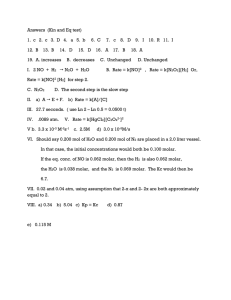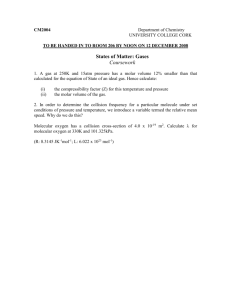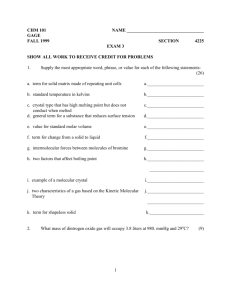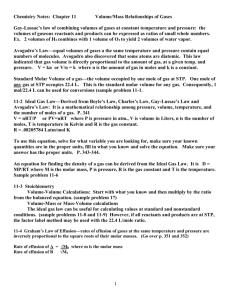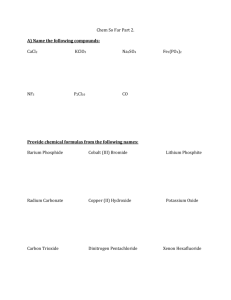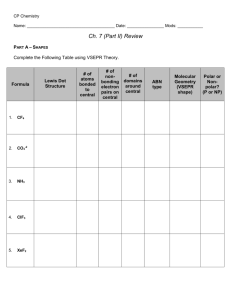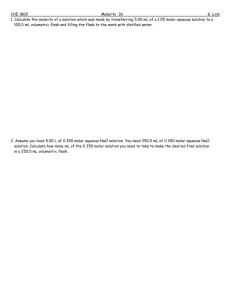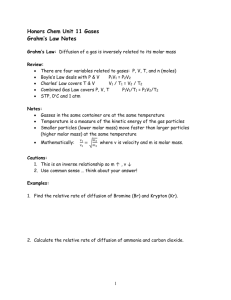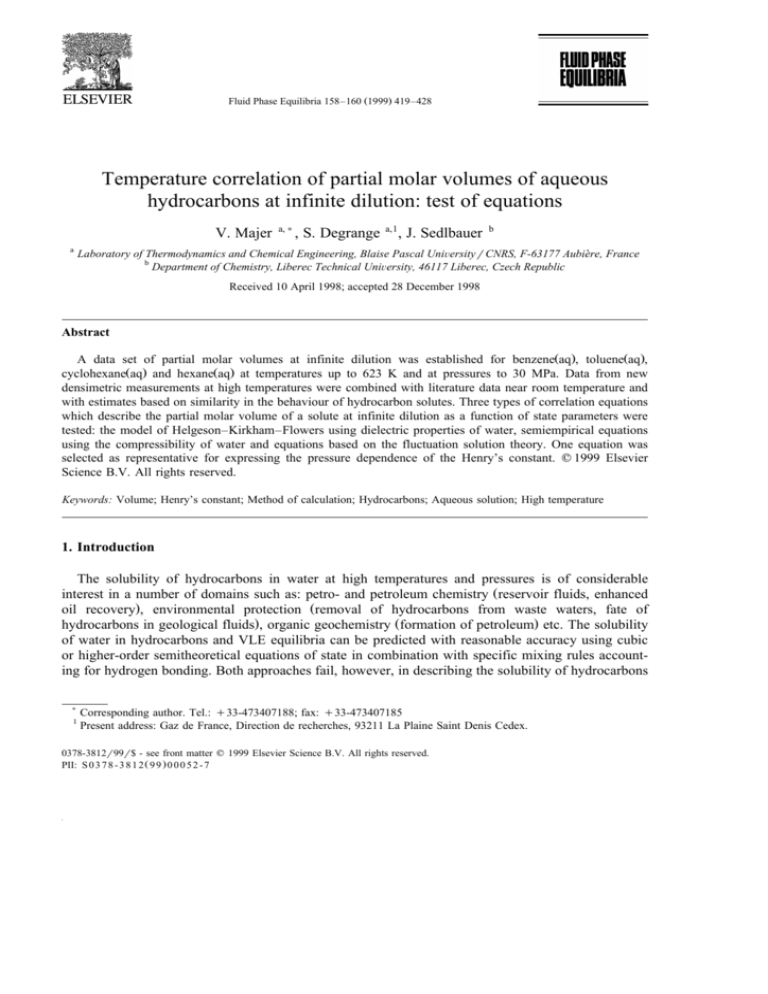
Fluid Phase Equilibria 158–160 Ž1999. 419–428
Temperature correlation of partial molar volumes of aqueous
hydrocarbons at infinite dilution: test of equations
V. Majer
a
a, )
, S. Degrange
a,1
, J. Sedlbauer
b
Laboratory of Thermodynamics and Chemical Engineering, Blaise Pascal UniÕersityr CNRS, F-63177 Aubiere,
` France
b
Department of Chemistry, Liberec Technical UniÕersity, 46117 Liberec, Czech Republic
Received 10 April 1998; accepted 28 December 1998
Abstract
A data set of partial molar volumes at infinite dilution was established for benzeneŽaq., tolueneŽaq.,
cyclohexaneŽaq. and hexaneŽaq. at temperatures up to 623 K and at pressures to 30 MPa. Data from new
densimetric measurements at high temperatures were combined with literature data near room temperature and
with estimates based on similarity in the behaviour of hydrocarbon solutes. Three types of correlation equations
which describe the partial molar volume of a solute at infinite dilution as a function of state parameters were
tested: the model of Helgeson–Kirkham–Flowers using dielectric properties of water, semiempirical equations
using the compressibility of water and equations based on the fluctuation solution theory. One equation was
selected as representative for expressing the pressure dependence of the Henry’s constant. q 1999 Elsevier
Science B.V. All rights reserved.
Keywords: Volume; Henry’s constant; Method of calculation; Hydrocarbons; Aqueous solution; High temperature
1. Introduction
The solubility of hydrocarbons in water at high temperatures and pressures is of considerable
interest in a number of domains such as: petro- and petroleum chemistry Ž reservoir fluids, enhanced
oil recovery., environmental protection Žremoval of hydrocarbons from waste waters, fate of
hydrocarbons in geological fluids., organic geochemistry Ž formation of petroleum. etc. The solubility
of water in hydrocarbons and VLE equilibria can be predicted with reasonable accuracy using cubic
or higher-order semitheoretical equations of state in combination with specific mixing rules accounting for hydrogen bonding. Both approaches fail, however, in describing the solubility of hydrocarbons
)
1
Corresponding author. Tel.: q33-473407188; fax: q33-473407185
Present address: Gaz de France, Direction de recherches, 93211 La Plaine Saint Denis Cedex.
0378-3812r99r$ - see front matter q 1999 Elsevier Science B.V. All rights reserved.
PII: S 0 3 7 8 - 3 8 1 2 Ž 9 9 . 0 0 0 5 2 - 7
420
V. Majer et al.r Fluid Phase Equilibria 158–160 (1999) 419–428
in water over a wider range of temperatures and pressures w1x. In such calculations it is preferable to
use the Henry’s law fs s Hs x s rather than equations of state. In this context the partial molar volumes
of hydrocarbon solutes in water extrapolated to infinite dilution Vs ( Žcalled the standard volumes of
solute for asymmetric choice of standard states. are of high interest. They allow changes in the
Henry’s constant Hs with pressure for hydrocarbon in water to be expressed as follows:
ln Hp2 y ln Hp1 s ln H
p2
p1 s
1
p2
H
RT p
Vs (d p
Ž1.
1
These changes are small near room temperature but become significant at elevated temperatures as
Vs ( of hydrocarbons increases strongly with increasing compressibility of water and diverges at the
critical point of the solvent.
Our objective was to collect a fair amount of data on the partial molar volumes at infinite dilution
of four typical hydrocarbons of medium molar mass Ž benzene, toluene, cyclohexane and hexane. and
to test different approaches to correlating these data as a function of state parameters up to 623 K
which is an upper temperature limit for most engineering applications. Measurements on two
vibrating tube flow densimeters w2,3x made it possible to obtain new data at superambient conditions.
These data were combined with those from literature for benzene and toluene near room temperature
and some estimates were carried out for cyclohexane and hexane where experimental information was
scanty. This made it possible to establish for the four hydrocarbons a data set of 64 values of the
partial molar volumes at infinite dilution in the temperature range between 278 and 623 K and at
pressures from 0.1 to 30 MPa.
The ability of several models to correlate the partial molar volume at infinite dilution of
hydrocarbon solutes over a wide temperature range reaching close to the critical point of water has
been tested. In all these models the volumetric behaviour of the solute scales at high temperature with
a selected property of water. The approach of Helgeson, Kirkham and Flowers Ž HKF. w4x uses
dielectric properties of water and has been widely used by geochemists for predicting chemical and
phase equilibria in natural systems at superambient conditions. This approach has severe deficiencies
when applied to organic solutes. Recently, new models have appeared where the variation of the
partial molar volume at infinite dilution of a solute is proportional to the compressibility Ž or pressure
derivative of density. of water which is in agreement with theories of near-critical solutions w5x. New
equations based on the fluctuation solution theory Ž FST. w6,7x have been recently proposed which
respect an ideal gas limit at low pressures.
In Sections 2–4, we present the data on the partial molar volume at infinite dilution, overview
briefly the equations used for correlation and summarize the results of tests. Finally we give
parameters of one promising equation expressing the partial molar volume at infinite dilution as a
function of state parameters and show how this equation can be used for converting the Henry’s
constant from one pressure to another.
2. Partial molar volumes at infinite dilution
A new flow instrument, calodensimeter w3x, combining a mixing calorimeter and a vibrating tube
densimeter in one thermostatted environment makes it possible to prepare a solution directly at a
V. Majer et al.r Fluid Phase Equilibria 158–160 (1999) 419–428
421
temperature of the experiment. This is particularly useful in our case as hydrocarbons, exhibiting
extremely low solubility at ambient conditions, become much more soluble at high temperatures. The
new data were obtained at temperatures from 473 K for benzeneŽ aq. and starting at higher
temperatures for other three hydrocarbons exhibiting slower kinetics of dissolution in water. The
measurements of density differences between hydrocarbonŽ aq. and water were carried out as a
function of concentration up to about 1 molrkg or lower depending on the solubility of a hydrocarbon
in water. The partial molar volumes at infinite dilution were obtained by extrapolation of the apparent
molar volumes correlated as a function of concentration. The reliability of these results was verified
on a second densimeter with a photoelectric detection w2x. A high sensitivity of this instrument made it
possible to carry out measurements with samples of a solution saturated with benzene at room
temperature Žconcentration of 0.022 mol per 1 kg of H 2 O at 298 K. starting from 373 K. The data
were determined at seven experimental conditions at temperatures up to 573 K. Correction of these
data to infinite dilution was easy to perform as the calodensimeter experiments have indicated that the
concentration dependence of apparent molar volumes for benzeneŽ aq. was not significant at these
experimental conditions. Measurements on both instruments were performed at elevated pressures of
10 and 30 MPa and were reasonably consistent. Description of these experiments with detailed results
can be found in Refs. w8,9x.
The newly determined data were complemented by selected literature values on Vs ( at near ambient
conditions for benzeneŽaq. and tolueneŽaq.. Several sources report the partial molar volumes at
infinite dilution at one temperature only Ž usually 298.15 K. ; the precise data over a limited
temperature interval by Sakurai w10x and those reaching up to 353 K by Makhatadze and Privalov w11x
are particularly valuable. In most cases the measurements were performed on vibrating tube
densimeters with a solution saturated with hydrocarbon at room temperature Ž Anton Paar, Sodev. .
Unfortunately, we have not found in literature any information on Vs ( of cyclohexaneŽ aq. and
hexaneŽaq. . Since our data were available for these two compounds only starting from 573 K, we
have estimated several values at lower temperatures. The volumes of pure solutes reported for
cyclohexane ŽRef. w12x at T s 298.15 K and Ref. w13x at higher temperatures. and hexane w14x were
combined with estimates of the differences in Vs (y Vs . by a procedure described in detail in Ref. w8x.
Comparison between the partial molar volumes at infinite dilution and molar volumes of pure solute
for benzene and toluene have shown w9x that their difference is negative at room temperature Žy6.3
and y9.4 cm3rmol for benzene and toluene, respectively. and becomes positive at temperatures
above 423 K. This evolution is due to two competing effects. Near room temperature where the
compressibility of water is low the hydrophobic interaction between water and hydrocarbon leads to
increase in the structuredness of water reflected by a decrease in Vs ( compared to Vs . . At high
temperature water becomes compressible and is less structured due to the thermal motion of
molecules. The nonelectrolyte solute repels water which leads at constant pressure to volume
expansion, the difference Vs (y Vs . will be positive and inversely proportional to the polarizability of
a nonelectrolyte molecule. This is confirmed by comparison of our new results on Vs ( at 573 K and
30 MPa with the data for pure solutes; the differences are 21, 30, 39 and 42 cm3rmol for benzene,
toluene, cyclohexane and hexane, respectively. Using this information as guidance we have estimated
Vs ( for cyclohexaneŽaq. and hexaneŽ aq. at 298.15, 373.15, 423.15, 473.15 and 523.15 K by adding to
the corresponding value of Vs . y10, y5, 0, 5 and 20 cm3rmol, respectively. In a similar way we
have also estimated for all compounds Vs ( at 298.15 K and 30 MPa expecting that the differences
Vs (y Vs . are not pressure dependent at this temperature.
V. Majer et al.r Fluid Phase Equilibria 158–160 (1999) 419–428
422
Table 1
Partial molar volumes of aqueous hydrocarbons as a function of temperature and pressure
T ŽK.
p ŽMPa.
Vs ( Žcm3 rmol.
s Vs ( Žcm3 rmol.
Ref.
Benzene(aq)
298.15
303.15
298.15
278.15
288.15
298.15
308.15
318.15
298.00
313.00
333.00
353.00
373.15
423.15
473.15
523.15
573.15
523.15
573.15
473.23
522.95
543.20
573.22
573.24
598.19
623.11
623.10
0.10
0.10
30.00
0.10
0.10
0.10
0.10
0.10
0.60
0.60
0.60
0.60
10.1
10.1
10.1
10.1
10.1
30.1
30.1
10.1
10.1
10.2
10.2
30.1
30.3
20.1
30.1
82.55
82.95
80.80
81.11
81.83
82.60
83.64
84.53
83.50
84.20
88.20
90.50
92.80
101.3
112.5
131.1
170.2
122.8
145.6
112.4
130.8
142.9
170.8
144.6
162.6
258.6
193.1
1.0
1.0
3.0
1.0
1.5
1.5
1.5
1.5
1.5
1.5
1.5
1.5
1.0
1.0
1.0
1.5
1.5
1.5
1.5
1.5
1.5
2.0
2.0
2.0
2.0
4.0
4.0
w15x
w16x
EST
w10x
w10x
w10x
w10x
w10x
w11x
w11x
w11x
w11x
w8,9x
w8,9x
w8,9x
w8,9x
w8,9x
w8,9x
w8,9x
w8,9x
w8,9x
w8,9x
w8,9x
w8,9x
w8,9x
w8,9x
w8,9x
Toluene(aq)
298.15
298.15
298.15
298.15
278.15
288.15
298.15
308.15
318.15
298.00
313.00
333.00
353.00
523.01
573.11
573.09
598.13
0.10
0.10
0.10
30.0
0.10
0.10
0.10
0.10
0.10
0.60
0.60
0.60
0.60
10.1
10.3
30.3
30.3
97.00
97.71
97.47
95.10
96.57
97.71
98.55
99.83
100.9
96.60
98.40
104.8
107.6
154.5
203.1
171.8
190.7
1.5
1.5
1.5
2.0
2.0
2.0
2.0
2.0
2.0
2.0
2.0
1.5
1.5
3.0
4.0
3.0
3.0
w17x
w18x
w15x
EST
w10x
w10x
w10x
w10x
w10x
w11x
w11x
w11x
w11x
w8,9x
w8,9x
w8,9x
w8,9x
V. Majer et al.r Fluid Phase Equilibria 158–160 (1999) 419–428
423
Table 1 Žcontinued.
T ŽK.
p ŽMPa.
Vs ( Žcm3 rmol.
s Vs ( Žcm3 rmol.
Toluene(aq)
623.10
623.11
20.1
30.4
303.7
225.8
6.0
6.0
w8,9x
w8,9x
Cyclohexane(aq)
298.15
298.15
373.15
423.15
473.15
523.15
573.24
573.24
598.09
622.94
623.12
0.10
30.1
9.90
9.90
9.90
9.90
10.3
30.4
30.4
20.2
30.6
98.70
95.70
112.7
126.3
142.4
173.4
223.0
187.1
207.7
345.5
254.2
4.0
4.0
5.0
5.0
5.0
7.0
15.0
10.0
5.0
6.0
5.0
EST
EST
EST
EST
EST
EST
w8x
w8x
w8x
w8x
w8x
Hexane(aq)
298.15
298.15
373.15
423.15
473.15
573.19
598.16
623.10
623.07
0.10
30.0
10.0
10.0
10.0
30.4
30.3
20.3
30.3
121.6
116.5
138.5
156.1
177.6
223.0
241.9
402.2
296.4
4.0
4.0
5.0
5.0
5.0
10.0
6.0
10.0
6.0
EST
EST
EST
EST
EST
w8x
w8x
w8x
w8x
Ref.
All the values of the partial molar volumes at infinite dilution used in tests are listed in Table 1 for
the four investigated compounds. Temperature T, pressure p, the partial molar volumes at infinite
dilution Vs (, expected error limit s Vs ( and literature reference are listed for each data point. Data
resulting from our measurements for benzene are designated in Table 1 as 9a or 9b depending whether
they were determined on the calodensimeter w3x or on the densimeter with photoelectric detection w2x.
Estimated data have a sign EST. Exceptionally high error margins were assigned to the values of Vs (
for cyclohexane and hexane at 573 K where the experimental uncertainty is high due to difficulties in
dissolving them in water. Selected data points are plotted in Fig. 1 in order to illustrate increase of Vs (
with increasing temperature and to visualise changes in volumes with the molecular structure of
hydrocarbons.
3. Correlation equations
The revised model of Helgeson, Kirkham and Flowers w4,19x is the best known approach to
correlating and predicting the standard thermodynamic properties of aqueous solutes at superambient
V. Majer et al.r Fluid Phase Equilibria 158–160 (1999) 419–428
424
Fig. 1. Selected partial molar volumes at infinite dilution of aqueous hydrocarbons Vs ( as a function of temperature: H, =,
benzeneŽaq. and tolueneŽaq. at 0.6 MPa w11x; ', l, benzeneŽaq. and tolueneŽaq. at 10 MPa w8,9x; ^, e, benzeneŽaq. and
tolueneŽaq. at 30 MPa w8,9x; `, I, cyclohexane and hexane at 30 MPa w8x. The lines have been drawn by eye.
conditions. A standard property of a solute is expressed as a combination of the so-called nonhydration and hydration contributions. The latter contribution, playing a role mainly at high temperatures, is
approximated by the Born equation as the model was originally proposed for aqueous electrolytes.
The same approach was used by analogy also for organic nonelectrolytes w20,21x although the
theoretical background is missing. The standard volume Žequal to the partial molar volume at infinite
dilution. is expressed as:
Vs ( s a1 q
a2
pqC
q
a3
TyQ
q
a4
Ž p q C .Ž T y Q .
v
y
´
2
E´
ž /
Ep
Ž2.
T
where a i and v are adjustable parameters, s 260 MPa, s 228 K and ´ is relative permittivity of
water. It has been shown recently that this model is not able to represent quantitatively the standard
thermodynamic data for aqueous nonelectrolytes over a wide range of state parameters w22x.
Schulte and Shock w23,24x proposed an analogue for organic solutes where both contributions are
modified; the dielectric properties of water were replaced by the pVT properties and the volumetric
equation takes a simple three-parameter form:
Vs ( s a q aT T y vk w
Ž3.
where the partial molar volume at infinite dilution is scaling with the compressibility of water k w at
high temperatures.
Criss and Wood w25x were inspired by the scaled particle theory w26x and expressed Vs ( as
Vs ( s a1 q a 2 T q a 3 k w RT
Ž4.
where the first constant term approximates the volume due to cavity creation, the second term
expresses interaction with the solvent and k w RT is the standard state term.
V. Majer et al.r Fluid Phase Equilibria 158–160 (1999) 419–428
425
Harvey et al. w27x derived a semiempirical expression relating the Henry’s constant of a solute to
the density of solvent which is asymptotically correct near the solvent’s critical point. By differentiating with respect to pressure they obtained a simple two parameter relationship for the difference
between the partial molar volume at infinite dilution and the molar volume of pure solute Vs (y Vw .
We have found, however, that this relationship fails completely when correlating data over a wide
range of temperatures in the subcritical region of water. It was possible to improve considerably
performance of this equation by introducing an additional adjustable parameter a1 multiplying the
volume of pure solvent:
Vs ( s a1Vw q R k w r w Ž a2 q a 3T exp Ž u . .
Ž5.
The exponential term with argument u s Ž273.15 y T .r50 was introduced empirically by Harvey et
al. for getting good data fit at low temperatures.
The FST links the integral of the direct solute–solvent correlation function at infinite dilution to the
dimensionless parameter A(s,ws Vs (rk w RT w22x which is well behaved near the critical point of
solvent. After a rearrangement this parameter can be also expressed in terms of a virial expansion
A(s ,w s lim
n s™0
ž
E Ž pVrRT .
En s
/
s 1 q Ž 2rM w . r w Bs ,w q PPP
Ž6.
T ,V , n w
where V is the overall volume of the system and Bs,w is the second cross virial coefficient. Using this
scheme O’Connell et al. w22x expressed Vs ( by a two parameter equation
Vs ( s RTk w 1 q r w Ž a1 q a 2 Ž exp y . r w y 1 . .
Ž7.
where y is a constant Ž5 cm3rg. . From comparison of Eqs. Ž 6. and Ž7. it follows that the second virial
coefficient is a constant Bs,w s Ž M wr2. a1.
It was found useful to introduce by analogy a parameter A w,w s Vwrk w RT related to the
water–water direct correlation function and virial expansion for pure water. By comparing the two
types of interactions it is possible to derive an analogous relationship w22x to Eq. Ž 7. :
Vs ( s Vw q RTk w r w Ž a1 q a 2 Ž exp y . r w y 1 . .
Ž8.
The parameter a1 approximates this time the difference between the cross and pure water second
virial coefficients. This is a smaller simplification compared to Eq. Ž 7. as the difference Bs,w y Bw,w is
likely to be less temperature dependent than Bs,w .
A more complex equation, derived analogously, was recently proposed by Sedlbauer et al. w28x
which we have used in a simplified 3-parameter form:
Vs ( s Vw q RTk w r w Ž a1 q a 2 Ž exp y . r w y 1 . q a 3 exp Ž urT . .
Ž9.
with u s 1500 K. In this approximation the difference in virial coefficients is a temperature dependent
function Bs,w y Bw,w s Ž M wr2.Ž a1 q a 3 expŽ urT .. which is more realistic compared to the approximation used in Eq. Ž 8. .
V. Majer et al.r Fluid Phase Equilibria 158–160 (1999) 419–428
426
4. Results of test and discussion
Performance of the above equations was tested on the four hydrocarbonsŽ aq. using weighted least
squares regression, with the expected errors in volumes used for determining the weighting factors of
individual data points. The standard Žs.d.. and the standard weighted Žs.w.d.. deviations of the fit are
summarised in Table 2. The standard weighted deviations for cyclohexane and hexane are systematically lower than those for benzene and toluene due to higher error margins for the former two
substances. BenzeneŽaq. presents the most stringent test as the data set contains 27 values at a variety
of conditions, the standard weighted deviation of its fit has therefore for most equations the highest
value of the four substances. The total number of adjustable parameters m p is in the second column;
m IC indicates the number of ill-conditioned parameters by what we mean the parameters whose
statistical uncertainties are larger than their absolute values.
It is apparent that the HKF model gives the worst results in correlation; the pressure dependent
terms have little effect on the fit, are redundant and lead in most cases to overfitting. The next three
models, Eqs. Ž3. – Ž6. using the compressibility of water w23–25x or the pressure derivative of density
w27x give similar satisfactory results in the fit of Vs ( with some ill-conditioning in the case of the
equation of Criss and Wood w25x. The two parameter equations based on the fluctuation solution
theory give only slightly worse s.w.d. and similar s.d. compared with the previous three-parameter
models. Eq. Ž7. fits the data somewhat better than Eq. Ž 8. which is consistent with results of fitting
Vs ( of aqueous nonelectrolytes of small molar mass w22x. The parameter a1 in the latter equation is
always ill-conditioned. This indicates that fitting the difference Vs (y Vw is not necessarily an
advantage when using simple two-parameter equations derived from FST. The extension of Eq. Ž 8. by
additional exponential term in temperature Žsee Eq. Ž 9.. leads to a clear improvement of the fit which
is remarkable in particular for benzeneŽaq. . Sedlbauer et al. w28x recommend the use of an additional
adjustable parameter multiplying Vw when correlating several thermodynamic properties simultaneously. Its inclusion is not, however, necessary when correlating volumetric data alone as it does not
improve significantly the fit and can lead to correlation among the parameters. Table 3 lists the
parameters of Eq. Ž9. which allow the calculation of Vs ( at superambient conditions, say between 298
Table 2
Test of equations for correlating the partial molar volume at infinite dilution Vs ( of aqueous hydrocarbons
Model
HKF w19,20x Ž2.
HKF a w19,20x Ž2.
Schulte w23,24x Ž3.
Criss and Wood w25x Ž4.
Harvey et al. w27x Ž5.
O’Connell et al. w22x Ž7.
O’Connell et al. w22x Ž8.
Sedlbauer et al. w28x Ž9.
a
mp
5
3
3
3
3
2
2
3
BenzeneŽaq.
b
m IC
s.d.
4
0
0
1
0
0
1
0
13.4
14.0
4.4
4.9
4.0
4.4
3.1
1.5
a2 s a 4 s 0 in Eq. Ž2..
Standard deviations Žs.d.. are in cm3rmol.
b
TolueneŽaq.
b
s.w.d.
m IC
s.d.
5.7
5.9
1.8
2.1
1.6
2.1
2.0
0.9
0
0
0
1
0
0
1
0
11.5
14.8
3.7
4.2
4.5
4.1
3.8
2.0
CyclohexaneŽaq.
b
s.w.d.
m IC
s.d.
3.2
4.3
1.0
1.2
1.3
1.6
1.7
0.8
4
0
0
0
0
0
1
1
19.4
16.4
6.5
7.4
6.4
4.5
6.5
2.7
Hexane Žaq.
s.w.d.
m IC
s.d.b
s.w.d.
2.1
2.4
0.7
0.8
0.8
0.8
1.3
0.5
4
0
0
0
0
0
1
0
8.3
14.5
4.5
5.0
6.3
6.6
7.9
4.9
1.6
2.1
0.8
0.8
1.0
1.3
1.6
0.9
V. Majer et al.r Fluid Phase Equilibria 158–160 (1999) 419–428
427
Table 3
Parameters of Eq. Ž9. for correlating the partial molar volume at infinite dilution of aqueous hydrocarbons
Parameter
3
a1 Žcm rg.
a 2 Žcm3rg.
a 3 Žcm3rg.
BenzeneŽaq.
TolueneŽaq.
CyclohexaneŽaq.
HexaneŽaq.
y0.783413
0.445695
y0.0412516
y1.33966
0.560937
y0.0578397
0.202312
0.588617
y0.100726
y1.03507
0.751594
y0.118074
and 623 K and pressures to 40 MPa. It does not give, however, quite realistic representation of the
pressure dependence of Vs ( at near ambient conditions Žsay below 373 K.. Since the volume is
changing little with pressure in this region such a deficiency will not affect significantly the
calculation of the pressure dependence of the Henry’s constant. Introducing Eq. Ž9. in relationship Ž1.
leads to the expression allowing to convert the Henry’s constant from a pressure where its value is
available to a pressure where the solubility of hydrocarbon in water is required:
ln H
p2
p1 s
1
RT
Gw
p2
p1 q
a1 r w q a2
ž
exp y . r w
y
p2
/
y r w q a 3 r w exp Ž QrT .
Ž 10.
p1
Term Gw denotes the molar Gibbs function of pure water. The Hill’s equation w29x was used to
calculate properties of water Ž Gw , r w .; the use of any other major equation for water should not cause
any significant imprecision.
5. List of symbols
a
B
G
H
M
R
p
T
V
V
adjustable parameter
second virial coefficient Ž volume per mol.
molar Gibbs function
Henry’s constant
molar mass
universal gas constant
pressure
temperature
volume
partial molar volume
Greek letters
Q
C
u
r
y
v
constant
constant
constant
density Žmass per unit volume.
constant
adjustable parameter
V. Majer et al.r Fluid Phase Equilibria 158–160 (1999) 419–428
428
Subscripts
s
w
Superscripts
(
.
solute
solvent Žwater.
infinite dilution
pure substance
References
w1x
w2x
w3x
w4x
w5x
w6x
w7x
w8x
w9x
w10x
w11x
w12x
w13x
w14x
w15x
w16x
w17x
w18x
w19x
w20x
w21x
w22x
w23x
w24x
w25x
w26x
w27x
w28x
w29x
I.G. Economou, C. Tsonopoulos, Chem. Eng. Sci. 52 Ž1997. 511–525.
V. Hynek, L. Hnedkovsky, I. Cibulka, J. Chem. Thermodyn. 29 Ž1997. 1237–1252.
V. Hynek, S. Degrange, M. Polednicek, V. Majer, J.R. Quint, J.-P.E. Grolier, J. Solution Chem., in press.
H.C. Helgeson, D.H. Kirkham, G.C. Flowers, Am. J. Sci. 281 Ž1981. 1249–1516.
J.C. Wheeler, Ber. Bunsenges. Phys. Chem. 76 Ž1972. 308–318.
J.G. Kirkwood, F.P. Buff, I. J. Chem. Phys. 19 Ž1951. 774–782.
J.P. O’Connell, Mol. Phys. 20 Ž1971. 27–33.
S. Degrange, PhD Thesis, Blaise Pascal University, Clermont-Ferrand, 1998.
S. Degrange, V. Majer, L. Hnedkovsky, V. Hynek, J. Chem. Eng. Data, submitted.
M. Sakurai, Bull. Chem. Soc. Jpn. 63 Ž1990. 1695–1699.
G.I. Makhatadze, P.L. Privalov, J. Chem. Thermodyn. 20 Ž1988. 405–412.
T.F. Sun, P.J. Kortbeek, N.J. Trappeniers, S.N. Biswas, Phys. Chem. Liq. 16 Ž1987. 163–178.
T.A. Apaev, A.M. Kerimov, Izv. Vyssh. Ucheb. Zaved., Neft Gaz 52 Ž1974. 78–106.
S.L. Randzio, J.-P.E. Grolier, J.R. Quint, D.J. Eatough, E.A. Lewis, L.D. Hansen, Int. J. Thermophys. 15 Ž1994.
415–441.
M.K. Dutta-Choudhury, N. Miljevic, A.V. Hook, J. Phys. Chem. 86 Ž1982. 1711.
D. Hetu,
´ A.H. Roux, J.E. Desnoyers, J. Colloid Interface Sci. 122 Ž1988. 418–429.
F. Shahidi, J. Chem. Soc., Faraday Trans. 77 Ž1981. 1511–1514.
J.E. Desnoyers, F.M. Ichhaporia, Can. J. Chem. 47 Ž1969. 4639–4643.
J.C. Tanger, H.C. Helgeson, Am. J. Sci. 288 Ž1988. 19–98.
E.L. Shock, H.C. Helgeson, Geochim. Cosmochim. Acta 54 Ž1990. 915–945.
J.P. Amend, H.C. Helgeson, Geochim. Cosmochim. Acta 61 Ž1997. 11–46.
J.P. O’Connell, A.V. Sharygin, R.H. Wood, Ind. Eng. Chem. Res. 35 Ž1996. 2808–2812.
M.D. Schulte, PhD Thesis, Washington University, Saint Louis, MO, 1997.
M.D. Schulte, E.L. Shock, in preparation, 1999.
C.M. Criss, R.H. Wood, J. Chem. Thermodyn. 28 Ž1996. 723–741.
R.A. Pierotti, Chem. Rev. 76 Ž1976. 717–726.
A.H. Harvey, J.M.H. Levelt-Sengers, J.C. Tanger, J. Phys. Chem. 95 Ž1991. 932–937.
J. Sedlbauer, J.P. O’Connell, R.H. Wood, Chemical Geology, in press.
P.G. Hill, J. Phys. Chem. Ref. Data 19 Ž1990. 1233–1274.

